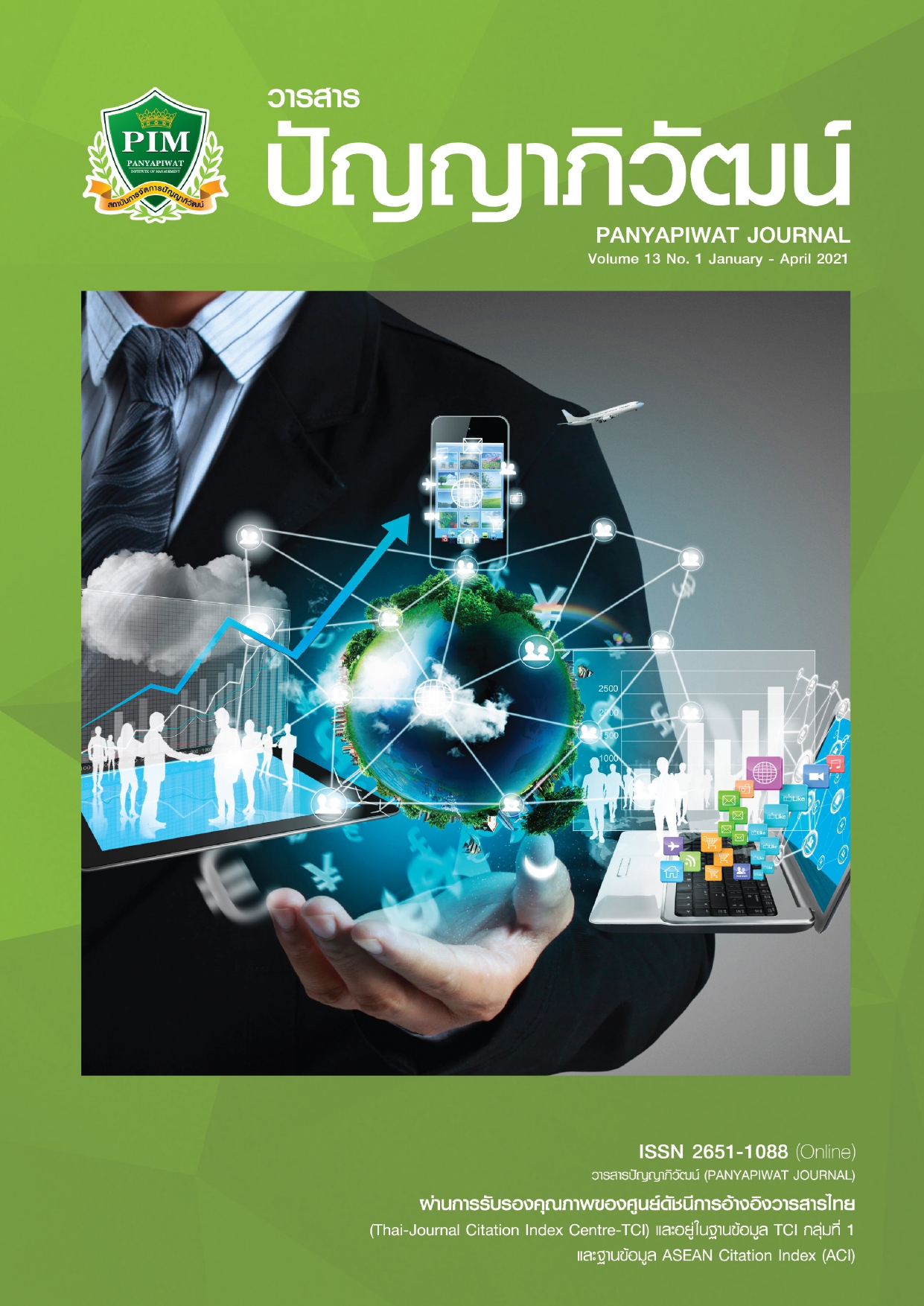ภาษากับการปลูกฝังอัตลักษณ์เด็กไทยในวรรณกรรมเพลงโรงเรียน
Main Article Content
บทคัดย่อ
การวิจัยนี้มีวัตถุประสงค์เพื่อศึกษาวงคำศัพท์การปลูกฝังอัตลักษณ์เด็กไทยในเพลงโรงเรียนที่แต่ง ช่วงแผนพัฒนาเศรษฐกิจและสังคมแห่งชาติฉบับที่ 10-12 และเพื่อศึกษาความสัมพันธ์ระหว่างวงคำศัพท์ กับยุทธศาสตร์การพัฒนาคนในแผนพัฒนาฯ ฉบับที่ 10-12 กลุ่มตัวอย่าง เพลงโรงเรียนสังกัดสำนักงานเขตพื้นที่การศึกษาประถมศึกษา 127 เพลง ประกอบด้วย เพลงที่แต่งช่วงแผนพัฒนาฯ ฉบับที่ 10 จำนวน 30 เพลง ช่วงแผนพัฒนาฯ ฉบับที่ 11 จำานวน 65 เพลง และช่วงแผนพัฒนาฯ ฉบับที่ 12 จำนวน 32 เพลงโดยสุ่มตัวอย่างแบบหลายขั้นตอน เครื่องมือ ตัวชี้วัดปลูกฝังอัตลักษณ์เด็กไทย และตัวชี้วัดยทธศาสตร์พัฒนาคนการวิจัยนี้เป็นเชิงคุณภาพและเชิงปริมาณ ใช้สถิติค่าความถี่และค่าร้อยละ ผลการวิจัย พบว่า 1) วงคำาศัพท์การปลูกฝังอัตลักษณ์เด็กไทยพบ 2 กลุ่ม คือ มนุษย์กับมนุษย์ ได้แก่ ถ การสืบทอดความรู้ ความเชื่อถือ วัฒนธรรมประเพณี และ ต การรวมกลุ่ม กลุ่มมนุษย์ ได้แก่ จ การ กระทำ การประพฤติ และ ฉ การดำารงชีวิต และ 2) ความสัมพันธ์ระหว่างวงคำาศัพท์กับยุทธศาสตร์การ พัฒนาฯ พบว่า แผนพัฒนาฯ ฉบับที่ 10 พบด้านเรียนรู้คู่คุณธรรม ด้านอยู่ร่วมกันในสังคมอย่างสันติ และด้านสุขภาวะที่ดี แผนพัฒนาฯ ฉบับที่ 11 พบด้านพัฒนาคนทั้งกาย ใจ สติปัญญา ด้านการศึกษาได้มาตรฐานสากล และด้านเพิ่มโอกาสทางการศึกษา และแผนพัฒนาฯ ฉบับที่ 12 พบด้านมีค่านิยมบรรทัดฐานดีทางสังคม ด้านเตรียมคนสำหรับโลกศตวรรษที่ 21 และด้านสุขภาวะที่ดี
Article Details
“ข้าพเจ้าและผู้เขียนร่วม (ถ้ามี) ขอรับรองว่า บทความที่เสนอมานี้ยังไม่เคยได้รับการตีพิมพ์และไม่ได้อยู่ระหว่างกระบวนการพิจารณาลงตีพิมพ์ในวารสารหรือแหล่งเผยแพร่อื่นใด ข้าพเจ้าและผู้เขียนร่วมยอมรับหลักเกณฑ์การพิจารณาต้นฉบับ ทั้งยินยอมให้กองบรรณาธิการมีสิทธิ์พิจารณาและตรวจแก้ต้นฉบับได้ตามที่เห็นสมควร พร้อมนี้ขอมอบลิขสิทธิ์บทความที่ได้รับการตีพิมพ์ให้แก่สถาบันการจัดการปัญญาภิวัฒน์หากมีการฟ้องร้องเรื่องการละเมิดลิขสิทธิ์เกี่ยวกับภาพ กราฟ ข้อความส่วนใดส่วนหนึ่งและ/หรือข้อคิดเห็นที่ปรากฏในบทความข้าพเจ้าและผู้เขียนร่วมยินยอมรับผิดชอบแต่เพียงฝ่ายเดียว”
เอกสารอ้างอิง
Basic Education Commission. (2018). Education Management Information System. Retrieved December 2, 2018, from https://data.bopp-obec.info/emis/ [in Thai]
Bunprasert, P. (2012). Nationalism Discourse of Thai Government (1932-2007 A.D). 49th Kasetsart University Annual Conference: Humanities and Social Sciences (pp. 183-190). Bangkok: Kasetsart University. [in Thai]
Bunsanit, Y. (1989). The Relationship between Literature and Society in the Development of Literature. Nonthaburi: Sukhothai Thammathirat University. [in Thai]
Howannappakorn, C. (2001). Communicative Meaning and Ideology in the University Songs. Master of Art in Speech Communication, Chulalongkorn University. [in Thai]
Leepreecha, P. (2003). Christian Conversion and Hmong Kinship Identity in Thailand. In Gepffrey B. H. (Ed.). Globalization and the Asian Economic Crisis: Indigenous Responses, Coping Strategies, and Governance Reform in Southeast Asia (pp. 161-174). Canada: Center for Southeast Asia Research, Institute of Asian Research,
University of British Columbia.
Leepreecha, P. (2003). The Relative Identity of the Hmong Ethic Groups in the Midst of Modern: Identity, Ethnic, Being Marginalized Person. Bangkok: Princess Maha Chakri Sirindhorn Anthropology Center (Public Organisation). [in Thai]
Panthumetha, N. (2016). Lexicals (7th ed.). Bangkok: Amarin Printing and Publishing. [in Thai]
Soikutrua, T. (2018). Language and Ideology of Dignity in the Discourse of School Marching Songs in Thailand. KKU International Journal of Humanities and Social Sciences, 8(3), 44-65.[in Thai]
The 10th National Economic and Social Development Plan (2007-2011). (2007). Bangkok: Office of the National Economics and Social Development Board. [in Thai]
The 11th National Economic and Social Development Plan (2012-2016). (2012). Bangkok: Office of the National Economics and Social Development Board. [in Thai]
The 12th National Economic and Social Development Plan (2017-2021). (2017). Bangkok: Office of the National Economics and Social Development Board. [in Thai]
Voegelins, C. F. (1957). Hopi Domain: A lexical Approach to the Problem of Section. International
Journal of American Linguistics, 14, 1-82.


